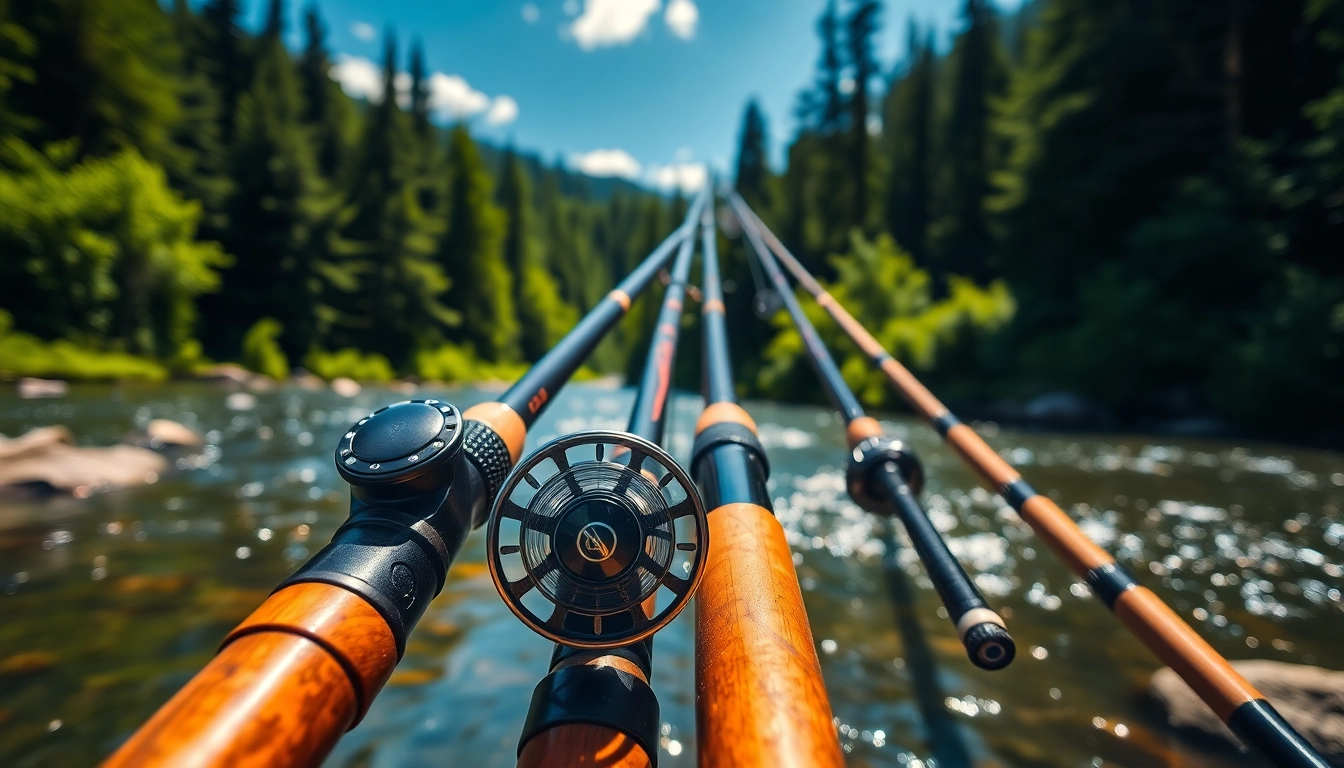Understanding the Basics of Fly Fishing Rods
When it comes to fly fishing, the rod you choose can significantly affect your success on the water. Fly fishing rods are distinct from conventional fishing rods not only in their design but also in their functionality, catering specifically to the unique requirements of fly casting. This article aims to explore the nuances of selecting the best fly fishing rods, ensuring you have the knowledge needed to make an informed choice.
What Makes a Fly Fishing Rod Unique?
Fly fishing rods are designed with a specific purpose in mind: to cast lightweight flies that mimic the natural prey of fish. Unlike spinning rods, which often utilize reels to cast heavy lures, fly rods leverage the weight of the line to propel the fly through the air. This makes them typically longer and more flexible, allowing for better line control and precision when casting. The unique taper of these rods contributes to their ability to generate a delicate presentation on the water surface.
Key Components of the Best Fly Fishing Rods
Understanding the main components of fly fishing rods is essential. A standard fly rod consists of:
- Blank: The main body of the rod, usually made from graphite or fiberglass, which determines the rod’s action and power.
- Guides: Small rings that run along the length of the rod, allowing for smooth line movement.
- Handle: Where the angler holds the rod, generally made from cork or foam for comfort.
- Reel seat: The mechanism that holds the fishing reel in place, critical for balance and function.
The Importance of Rod Length and Weight
Rod length and weight play a crucial role in casting efficiency and accuracy. Longer rods (9 to 10 feet) provide greater leverage and distance, making them ideal for larger bodies of water. Shorter rods (7 to 8 feet), on the other hand, are better suited for smaller streams where precision and control are vital. The weight of the rod is categorized through a rating system (often from 1 to 14), correlating to the line weight they are designed to cast; a 5-weight rod, for example, works well with a line of the same weight, offering versatility for a range of fish species.
Selecting the Right Fly Fishing Rod for Your Style
Choosing a fly rod that complements your fishing style is essential for overall enjoyment and effectiveness. This section delves into the various factors influencing your selection process.
Matching Rod Types with Fishing Techniques
Different fishing techniques necessitate different rod designs and specifications. For instance, if you predominantly fish in still waters using dry flies, a slower action rod may enhance your casting accuracy. Conversely, for fast-moving rivers and streamers, you might opt for a fast action rod that provides more power and quicker line recovery. Understanding your preferred fishing technique will help narrow down the types of rods to consider.
Evaluating Action and Power Ratings
Action refers to how much of the rod flexes during a cast. There are three main categories:
- Fast Action: Flexes mostly in the tip, allowing for quick, powerful casts.
- Medium Action: Flexes throughout the middle of the rod, providing a balance of power and sensitivity.
- Slow Action: Flexes from the butt to the tip, offering excellent sensitivity but less casting distance.
Power ratings indicate the rod’s ability to handle different sizes and weights of fish. Selecting a rod with an appropriate action and power rating for your target species is vital for a successful outing.
Choosing Between Freshwater and Saltwater Rods
Freshwater and saltwater fishing rods are built to withstand different environmental conditions. Freshwater rods are typically lighter, targeting species like trout and panfish. Saltwater rods, however, are designed to withstand harsher conditions; they feature corrosion-resistant materials and stronger guides to handle larger fish like tarpon and marlin. It’s important to select a rod tailored to the environment in which you will be fishing.
Features to Look for in the Best Fly Fishing Rods
Assessing various features of fly fishing rods will ensure you make a choice that best suits your needs.
Material Options: Graphite vs. Fiberglass
When it comes to materials, graphite and fiberglass are the two primary options. Graphite rods are lightweight, sensitive, and offer superior performance, making them the preferred choice among experienced anglers. However, they come at a higher price point. Fiberglass rods are heavier and generally more flexible, providing a forgiving action that can be beneficial for beginners. Understanding the pros and cons of each material helps you choose the most suitable option.
Handle Types for Comfort and Grip
The handle material can significantly impact your fishing experience. Cork handles are a traditional favorite due to their comfort and warmth, while EVA foam handles offer durability and moisture resistance. The shape also plays a role; a larger grip could be beneficial for those with larger hands, while smaller grips allow for greater precision. Testing various handle types may help identify the most comfortable option for extended periods of fishing.
Guides and Reel Seats: What You Need to Know
Guides are as crucial as the rod itself; they affect line movement and casting performance. High-quality, lightweight guides reduce friction, allowing for smooth line flow. Reel seats should be sturdy yet lightweight, ensuring the reel stays secure during fishing. Attention to these components ensures stability and reliability in performances.
Caring for Your Fly Fishing Rod
Taking proper care of your fly fishing rod not only extends its lifespan but also enhances your fishing experience.
Maintenance Tips to Extend Rod Life
Regular maintenance is crucial. Inspect your rod for any cracks or damage before and after each use. Storage is equally vital; avoid leaving your rod in van trunks or garages exposed to extreme temperatures. Additionally, using rod sleeves can prevent accidental damage during transport.
Cleaning Techniques for Different Materials
Cleaning the rod after each use is simple but essential. For graphite rods, a gentle wash with warm water and a mild soap is sufficient. Fiberglass rods can typically handle a bit more rigorous cleaning, but should also avoid abrasive materials to prevent scratching. Refrain from using anything that could damage the surface. After the cleaning process, ensure the rod is thoroughly dried before storing it away.
Storing Your Fly Fishing Rod Properly
Proper storage ensures your rod retains its shape and functionality. It’s best to store fly rods in a vertical position or flat in a rod case to maintain their integrity. Avoid coiling the line, as this can lead to tangles or damages. A dedicated rod storage solution or case will help keep your rods organized and in peak condition.
Recommendations and Reviews of the Best Fly Fishing Rods
In this section, we round up several highly rated fly fishing rods tailored to various skill levels and requirements. These selections aim to provide valuable insights and actionable information for anglers.
Top-Rated Rods for Beginners
Beginners should seek rods that are forgiving, versatile, and easy to handle. Rods in the 8-9 weight range often provide a balanced experience. Brands offering beginner kits that include both the rod and reel can facilitate a smoother entry into the sport. Look for a lightweight design that enhances castability without compromising on performance.
Best Fly Fishing Rods for Intermediate Anglers
Intermediate anglers may desire rods that offer increased sensitivity and versatility, suitable for various fishing environments. Consider mid-priced options that utilize advanced materials, providing excellent performance without breaking the bank. Medium-fast action rods typically serve well for casting in different conditions, ensuring that anglers can adapt their techniques easily.
Premium Options for Serious Enthusiasts
Serious fly fishing enthusiasts will appreciate high-end rods that incorporate cutting-edge technology and materials, such as carbon fiber. These rods generally feature superior action and weight, allowing for long casts and acute sensitivity. Investing in a top-rated rod ensures an enjoyable fishing experience and improves the likelihood of catching more fish.




